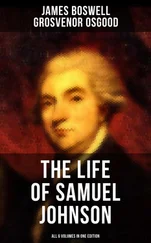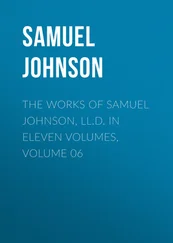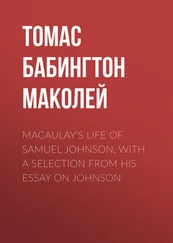James Callender - Deformities of Samuel Johnson, Selected from His Works
Здесь есть возможность читать онлайн «James Callender - Deformities of Samuel Johnson, Selected from His Works» — ознакомительный отрывок электронной книги совершенно бесплатно, а после прочтения отрывка купить полную версию. В некоторых случаях можно слушать аудио, скачать через торрент в формате fb2 и присутствует краткое содержание. Жанр: foreign_antique, foreign_prose, на английском языке. Описание произведения, (предисловие) а так же отзывы посетителей доступны на портале библиотеки ЛибКат.
- Название:Deformities of Samuel Johnson, Selected from His Works
- Автор:
- Жанр:
- Год:неизвестен
- ISBN:нет данных
- Рейтинг книги:4 / 5. Голосов: 1
-
Избранное:Добавить в избранное
- Отзывы:
-
Ваша оценка:
- 80
- 1
- 2
- 3
- 4
- 5
Deformities of Samuel Johnson, Selected from His Works: краткое содержание, описание и аннотация
Предлагаем к чтению аннотацию, описание, краткое содержание или предисловие (зависит от того, что написал сам автор книги «Deformities of Samuel Johnson, Selected from His Works»). Если вы не нашли необходимую информацию о книге — напишите в комментариях, мы постараемся отыскать её.
Deformities of Samuel Johnson, Selected from His Works — читать онлайн ознакомительный отрывок
Ниже представлен текст книги, разбитый по страницам. Система сохранения места последней прочитанной страницы, позволяет с удобством читать онлайн бесплатно книгу «Deformities of Samuel Johnson, Selected from His Works», без необходимости каждый раз заново искать на чём Вы остановились. Поставьте закладку, и сможете в любой момент перейти на страницу, на которой закончили чтение.
Интервал:
Закладка:
This seems to be the production of some ingenious but angry Scotchman, who has taken great pains to prove, what all the world knows, that there are many exceptionable passages in the writings of Dr. Johnson. There are, however, few spots in this literary luminary now pointed out that have not been discovered before. So that the present map must be considered rather as a monument of the delineator's malignity, than of his wit. – His personalities seem to indicate personal provocation; though perhaps it may be all pure nationality .
Though Boswell mentions the pamphlet and quotes a letter in which Johnson comments on it, 6 6 Writing to Boswell on 28 March 1782, Johnson remarks: "The Beauties of Johnson are said to have got money to the collector; if the 'Deformities' have the same success, I shall be still a more extensive benefactor" ( The Letters of Samuel Johnson , ed. R. W. Chapman [Oxford, 1952], II, 475).
neither he nor any of his editors before L. F. Powell try to identify the incensed author. In 1815 Robert Anderson said that the Deformities , "an invidious contrast to 'The Beauties of Johnson,'" is "the production of Mr. Thomson Callender, nephew of Thomson the poet." 7 7 Life of Samuel Johnson, LL.D. With Critical Observations on His Works (3rd ed.; Edinburgh, 1815), p. 231. Anderson is apparently incorrect in saying that Callender was Thomson's nephew.
When the Deformities was catalogued in the Bodleian Library in 1834, 8 8 There is apparently no copy of A Critical Review in the Bodleian.
it was attributed to John Callander of Craigforth. In A Critical Review of the Works of Dr. Samuel Johnson , the statement is made (p. 4) that "Mr. Callander of Craigforth … observes" that "'Had the laborious Johnson been better acquainted with the oriental tongues, or had he even understood the first rudiments of the northern languages from which the English and Scots derive their origin, his bulky volumes had not presented to us the melancholy truth, that unwearied industry, devoid of settled principles , avails only to add one error to another.'" This latter blast, taken from the "Introduction" to Callander's Two Ancient Scottish Poems, The Gaberlunzie Man and Christ's Kirk on the Green (Edinburgh, 1782), may well have been the evidence that caused A Critical Review to be attributed to John Callander of Craigforth; then, because of the interconnections between it and the Deformities and because of their convincing similarity, the Deformities was also assigned to him. On the other hand, one is puzzled by the Bodleian's failure to accept the passage from John Callander in A Critical Review as conclusive evidence that he was not the author of that work. 9 9 In his Introduction to a recent reprint (New York, 1965) of John Rae's Life of Adam Smith (1895), Jacob Viner (who expresses his indebtedness to "Herman W. Liebert for bringing A Critical Review to my attention and for warning me that J. T. Callender, its author, was probably also the author of Deformities of Dr. Samuel Johnson ") concludes that the quotation from John Callander in A Critical Review is sufficient "to acquit John Callander of any responsibility for authorship of either Deformities of Samuel Johnson or A Critical Review " (p. 68; see also pp. 62-69).
When the Deformities and A Critical Review were catalogued in the British Museum, in 1854 and 1862, they were likewise attributed to John Callander of Craigforth. In 1915 Courtney and Smith seemed to doubt that John Callander wrote them; for, they noticed, "strangely enough no mention of them is made by Robert Chambers in his memoir of Callander." 10 10 William P. Courtney and D. Nichol Smith, A Bibliography of Samuel Johnson (Oxford, 1915; reissued with facsimiles, 1925), p. 136.
The Catalogue of Printed Books in the Edinburgh Library (1918) assigns A Critical Review to John Callander; it does not list the Deformities . Arthur G. Kennedy, in A Bibliography of Writings on the English Language (1927), attributes the Deformities to John Callander; he lists the 1787 issue of A Critical Review as anonymous. In their Dictionary of Anonymous and Pseudonymous English Literature (1926-1932), Halkett and Laing assign A Critical Review to John Callander on the authority of the British Museum; the Deformities is also assigned to him on the authority of a note by Chalmers in 1782.
Finally, L. F. Powell, primus editorum , in his revision of G. B. Hill's edition of Boswell's Life (1934-1950), quoted from a letter by James Thomson Callender to John Stockdale, dated 4 October 1783, which says: "I will be greatly obliged to you, for delivering the remaining Copies of Deformities of Johnson to the bearer, and sending me his Receipt for them." Dr. Powell thinks – rightly, we believe, when all the other evidence is taken into account – that this letter "shows" that Callender "was the author of the book." 11 11 Life , IV, 499. Callender's letter itself, reproduced in the R. B. Adam Library (III, 48), is now in the Hyde Collection. Dr. Powell, like Robert Anderson, says that James Thomson Callender was a nephew of the poet James Thomson, and gives the DNB as the source of his information.
Then in 1940, D. Nichol Smith, no doubt having followed the suspicion he and W. P. Courtney expressed in 1915, and having available the proof unearthed by Dr. Powell, attributed both items to J. T. Callender in the CBEL (II, 627), listing two editions of the Deformities in 1782 and two of A Critical Review in 1783. The British Museum Catalogue also now credits the same Scotsman with both works.
The information in Callender's letter to Stockdale, Anderson's identification, a fairly plausible reason that the Deformities was so long attributed to John Callander, the similarity of the styles and contents of the two pamphlets, the parallel circumstances of publication, the virtual acknowledgement of the Deformities in A Critical Review – all point to a safe conclusion that the two works were the creations of James Thomson Callender.
Though students of Johnson have frequently noticed the bitter ridicule in the Deformities and A Critical Review , they (since the author of the pamphlets was unknown) have seldom, 12 12 In 1962, one of the present writers, J. E. Congleton, published an article on "James Thomson Callender, Johnson and Jefferson" ( Johnsonian Studies [Cairo, 1962], pp. 161-172) which forms the basis of a part of the present introduction.
if ever, detailed Callender's turbulent career in America. Similarly, students of American history have studied Callender's attacks on early American statesmen; but they have been completely unaware, it seems, that the pamphleteer who wrote them began his career by making fun of Samuel Johnson. Now that the authorship of these two early productions has been established, a study of them provides details that illuminate the foreground of Callender's career in America. Likewise, of course, the particulars of his activities in America illuminate the background of his career in Great Britain.
Near the conclusion of the Deformities , Callender relates the "circumstances which," as he says, "gave … birth" to the work.
In 1778, Mr William Shaw published an Analysis of the Gaelic language. He quoted specimens of Gaelic poetry, and harangued on its beauties… A few months ago, he printed a pamphlet. He traduced decent characters. He denied the existence of Gaelic poetry, and his name was echoed in the newspapers as a miracle of candour. Is there in the annals of Grubæan impudence any parallel to this?.. This incomparable bookbuilder, who writes a dictionary before he can write grammar, had previously boasted what a harvest he would reap from English credulity. He was not deceived. The bait was caught… Mr Shaw wants only money… But better things might have been expected from the moral and majestic author of the Rambler. He must have seen the Analysis of the Gaelic language, for Shaw mentions him as the patron of that work. He must have seen the specimens of Celtic poetry there inserted. That he is likewise the patron of this poor scribble, no man, I suppose, will offer to deny. From this single circumstance, Dr Johnson stands convicted of an illiberal intention to deceive . Candour can hardly hesitate to sum up his character in the vulgar but expressive pollysyllable [pp. 86-87].
Читать дальшеИнтервал:
Закладка:
Похожие книги на «Deformities of Samuel Johnson, Selected from His Works»
Представляем Вашему вниманию похожие книги на «Deformities of Samuel Johnson, Selected from His Works» списком для выбора. Мы отобрали схожую по названию и смыслу литературу в надежде предоставить читателям больше вариантов отыскать новые, интересные, ещё непрочитанные произведения.
Обсуждение, отзывы о книге «Deformities of Samuel Johnson, Selected from His Works» и просто собственные мнения читателей. Оставьте ваши комментарии, напишите, что Вы думаете о произведении, его смысле или главных героях. Укажите что конкретно понравилось, а что нет, и почему Вы так считаете.












